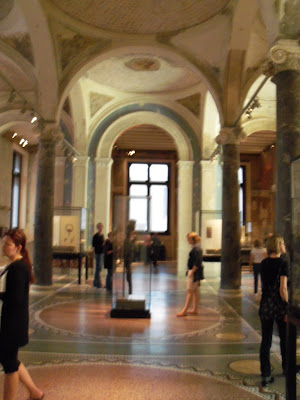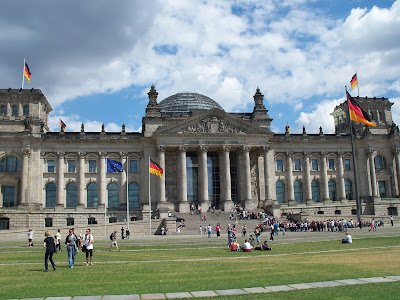I highly recommend that anyone who is visiting Berlin and is getting a little overwhelmed with the size of Germany’s capital visit Potsdam. It has a small town feel and the food and beer is all a lot cheaper than it was in the city. Now for the part that makes Potsdam the Versailles of Germany. Potsdam was the home of the Prussian kings from around [insert date]. Prussia was a part of the Holy Roman Empire that became increasingly powerful. It was Austria’s arch rival for control over the other German states, and with its Protestant king, it was immensely popular and powerful in the north. Prussia was relatively small when compared to the other states of Europe and it was only a highly trained and well disciplined army that allowed it to not only fend off its rivals, but expand into their territory. Frederick William the "Soldier King" forged the Prussian army into the single most efficient fighting force on the continent and his son, Frederick II der Grosse, Frederick the Great, used that army to launch Prussia into the status of a world power.
Under the machinations of Otto von Bismarck in the mid to late 1800’s Prussia rose to the height of its power. Prussia fought three wars in quick succession, the wars of unification. First, Bismarck forged a temporary alliance with Austria; in theory, the two German states would go to the "defense" of Schleswig, a German duchy under the control of Denmark. It did not go well for Denmark and in less than a year, they ceded Schleswig-Holstein to German Confederation. Theoretically Austria and Prussia would dually administer the new territories, but Prussia's status as a Protestant state made it much more popular and as the two states vied for supremacy tensions exploded. In 1866, Austria declared war. Foolish of them because under the generalship of Helmuth von Moltke the Elder, the Prussians annihilated the advancing Austrian army in a single battle. Bismarck wanted Austria as an ally not an enemy, and used Napoleon III of France as a mediator and peace was restored, albeit with Prussia in charge off all of Northern Germany. Ironically, the arbiter of peace for that war, Emperor Napoleon III of France, was diplomatically outmaneuvered by Bismarck just four years later. Napoleon, like the Austrians, foolishly declared war on Prussia. Again, the Prussian military under von Moltke crushed the French forces at the Battle of Sedan in 1870, and captured Napoleon. Even before the last war was over, the German Empire was declared from Versailles Palace. With that declaration the Prussian king became Wilhelm I, Emperor of the Germans.
Unfortunately, only one of the palaces was open, the Neues (New) Palace…
Now for my diatribe against all Europeans: Why are the museums closed on Mondays!! For heaven’s sake, you are in the middle of the tourist season and you close the attractions. That is so stupid that you would think that a monkey who fell out of a tree could come up with a better way to make money!! No wonder you are having so much trouble with your economies!! If the Germans are being this economically irresponsible and lazy the rest of the continent is probably doomed!!
By the time I actually got to the ticket office for the one that was open I was too infuriated to purchase the photo permit, so yet again, I have no pictures of the palace. You aren’t missing much with the exception of “the Grotto.” Over a quarter million seashells were used to create the mosaics that covered the walls and the ceilings. It was really dark so I doubt any pictures would have come out anyways. They rest of the palace was only memorable because it had original flooring and they made us wear giant slippers over our shoes so as not to damage what was left.
Even though I was disappointed with the palaces not being open the palace grounds contributed magnificently to what I said about palace gardens always being worth a walk…
That is the main palace at the top of the hill. [name]
That is the Orangerie with Frederick the Great in front. Even though the terraced and landscaped gardens were neat, it was the untouched grounds that resembled the forest that I liked walking though the most…
As you can see, I think the German summer has been a little low on rain for quite some time. Oh well, the walk reminded me a lot of home. The same is true of the train ride through Northern Germany and Denmark. I am watching Danish farmland go past the window. It is a little strange because I keep remembering that I am on an island, but I see red barns, machine sheds, and steel grain bins. I am also seeing a windmills. Not the wooden ones you think of, but the big ones made for generating electricity, again a lot like the drive across Iowa. I am not getting homesick, I am just reflecting on what it is that I truly call home.


















































